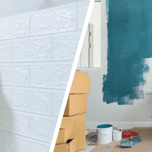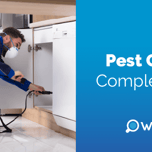- whatcost.co.uk
- Heat Pumps
- Compare Heat Pumps
- Air Source Vs Ground Source
Air Source Heat Pumps vs Ground Source Heat Pumps: Which Is Better?


With more homeowners looking to save energy and practise sustainable living, it’s no surprise that heat pump installations have increased by 26% since 2023. These systems use renewable energy, are highly efficient and can offer huge savings, but with two main types on the market, air source heat pumps (ASHPs) and ground source heat pumps (GSHPs), which is better?
In this article, we’ll look at what sets a heat pump apart from traditional heating systems, the crucial difference between a ground source and air source heat pump, and compare key aspects to determine which is most suitable for different homes across the UK.
We’ll also look at grant funding opportunities to see how access to heat pumps is improving. While discovering which of these two heat pumps is the best solution, when considering the pros and cons.
- Understanding how heat pumps work
- Comparing air source vs ground source heat pumps
- Environmental impact of air source heat pumps vs ground source heat pumps
- What to consider when choosing a ground source heat pump or air source heat pump
- Which heat pump is the most recyclable?
- Which heat pump type is most suitable for your home?
- Heat pump tips to consider
- Expert opinions and recommendations
- Final verdict: Choosing between air and ground
- Frequently asked questions
Understanding how heat pumps work
Heat pumps transfer heat from naturally occurring sources, such as the air, the ground or even water bodies, and send it into your home. They do this by heating a fluid (called refrigerant) within their pipes, which can be compressed to increase its temperature. This fluid then turns to vapour and circulates through your home's heating system to heat radiators and tap water.
Different types of heat pumps can work in slightly different ways, so it can be confusing to know which is the most effective for each property type. To highlight the key differences, we’ve detailed below how an air source heat pump and a ground source heat pump work.
Air source heat pumps
Below are the steps which show how an air source heat pump works.
1. Taking heat from outside - The outdoor unit of an air source heat pump draws in ambient air that’s naturally occurring outside. This air is warm enough to heat the refrigerant inside the heat pump pipes.
2. Heating the refrigerant - As the refrigerant heats, it passes through a compressor, increasing the temperature. This changes the fluid into a vapour.
3. Transfer of heat - As the refrigerant vapour reaches very high temperatures, it can be sent around your home heating system (through the pipework) to heat water for taps and radiators or air conditioning systems to channel warm air into the home.
4. Cooling off - After the refrigerant has transferred its heat to your water or air conditioner, it starts to cool. As it cools, it returns to a fluid state and cycles back around the pipes, returning to the outdoor unit to begin the process again.
It’s important to note that air source pumps come in two main types:

-
Air-to-water heat pumps
This is the most common air source heat pump type because it can transfer heat to your hot water and radiators. This makes it an excellent choice if you are looking to replace a traditional boiler system with a low-carbon alternative.

-
Air-to-air heat pumps
These heat pumps can only transfer heat directly to vented air heating systems or fan units. This means you will still need some kind of boiler or water heater to produce hot water for your property.
Air source temperatures
Air source heat pumps work most effectively when a property is well insulated, this ensures the heat pump doesn’t work overtime trying to meet high heating demands. They also work better with underfloor heating or large radiators, because air source heat pumps operate at lower temperatures than traditional gas boilers.
Where a boiler can reach typical heating temperatures of 70°C, an air source heat pump will reach between 30 - 40°C. This lower flow temperature means they work best over a larger surface area, such as underfloor heating or oversized radiators, to provide adequate heat output. Some make and models will offer higher output potentials, but this can increase costs.
If you’re fitting an air-to-water heat pump in an older property, you may need to consider the costs of replacing your radiators or enhancing your insulation to get the most from a heat pump.
Ground source heat pumps
Ground source heat pumps, also known as geothermal heat pumps, work similarly to air source pumps, with the only key difference being where they obtain their natural heat - from underground rather than the air. Here is how a ground source heat pump works:
1. Underground loop - A liquid solution, typically a water-antifreeze mix called brine, circulates through a network of pipes buried in the ground. This loop can be laid out in horizontal trenches or vertically in what’s known as boreholes.
2. Heat transfer - The ground maintains a relatively constant underground temperature, which is used to warm the circulating brine. The brine then carries the absorbed heat to a heat pump unit inside your house.
3. Compression and condensation - A compressor pressurises the warmed brine inside the heat pump, further increasing its temperature. This hot brine transfers heat to your home's heating system to heat your water and radiators.
4. Brine Re-cooling - The now-hot brine circulates back through the system and underground, where it loses its heat back into the cooler ground, getting ready for the next heating cycle.
6. Summer cooling - Some ground source heat pumps (if equipped) can reverse this process in summer to provide home cooling. The heat pump can extract heat from the inside of the home and transfer it to the cooler ground through the brine circulation.
There are two main types of ground source heat pumps to consider based on pipe placement:

-
Horizontal closed loop
In this scenario, the closed loop pipes are buried horizontally in trenches around 2 metres deep across a large land area. This is suitable for properties with ample outdoor space.
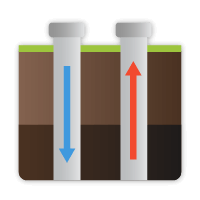
-
Vertical closed loop
Pipes can be inserted into vertical boreholes drilled up to 200 metres deep. This is a good option for properties with less space but can be more expensive due to drilling costs.
Ground source temperatures
Similar to an air source heat pump, ground source pumps operate at much lower flow temperatures than a typical gas boiler. A ground source heat pump will offer 35 - 45°C, which is ideal for underfloor heating. Advanced ground source heat pumps can also provide hot water temperatures up to 70°C, making these models compatible with standard radiators.
Due to fairly consistent ground temperatures of 8-12°C in the UK, a ground source heat pump can provide efficient heating and hot water year-round. This makes them less affected by weather and seasonal changes than an air source heat pump.
Comparing air source vs ground source heat pumps
Air source and ground source heat pumps (also known as geothermal heat pumps) are both highly efficient, renewable and low-carbon technologies. They each offer a range of benefits but also come with key considerations.
When deciding upon a type of heat pump for any property, there are some main factors you should consider. These include costs, efficiency, quality and user-friendliness. Before deciding which kind of heat pump is better, let’s look at these areas closely.
Cost of air source and ground source heat pumps
The upfront cost is a major consideration when choosing between these two types of heat pump. Air source heat pump prices range from £2,400 and £14,050 for installation, whereas you can expect to pay between £16,200 - £49,000 for a ground source heat pump.
Air source are generally considered to be more affordable, but ground source heat pumps can be more energy efficient, lowering their running costs over time.
Costs are likely to be affected by factors such as heat pump size, brand and technology. For example, the higher your home's demand for heating and hot water, the stronger the heat pump you will need - with more power comes high costs.
There are also cost differences between air-to-air and air-to-water, as well as installation cost differences if you opt for horizontal or vertical ground source loops. We’ve included some estimated figures in the table below to give you a brief idea of costs.
| Heat Pump Cost Comparisons | ||
|---|---|---|
| Heat pump type | Supply range | With installation |
| Air-to-air | £2,050 - £7,100 | £2,400 - £8,800 |
| Air-to-water | £8,400 - £12,350 | £8,750 - £14,050 |
| Ground source (Vertical) | £13,200 - £19,000 | £23,200 - £49,000 |
| Ground source (Horizontal) | £13,200 - £19,000 | £16,200 - £31,000 |
It should be noted that a heat pump installation can come with an array of additional work or fees. Below are some examples:
-
Insulation to the property (to improve heat pump efficiency): £9,000 - £31,000
This can include a cavity, roof, and floor insulation, as well as installing underfloor heating and upgrading to larger radiators.
-
Pipeworks: £2,000 - £4,000
Ground source heat pumps, in particular, can incur costs for new or re-fitted piping.
-
Groundwork (including digging/drilling): £3,000 - £20,000
These costs vary greatly depending on whether you opt for horizontal or vertical ground source loops. Drilling vertical boreholes typically costs £25 - £40 per metre depth, plus mobilisation costs. A 100m borehole, contributing 4kW, can cost £4,000 - £6,000 to drill.
-
Heat pump size:
Each heat pump will have a size, otherwise known as an ‘output’, indicating how powerful it is (or how much heat it produces). For example, an 8kW air source heat pump would suit smaller properties with 1 - 2 bedrooms. Whereas a 16kW heat pump would suit a larger home with up to 5 bedrooms. On average, however, an 8kW system will cost around £9,700, but a 16kW would be over £12,000.
The cost of installing a heat pump can seem overwhelming, but air source heat pumps are certainly at the lower end of the price range, from £2,400 - £14,050. Ground source heat pumps, on the other hand, come with very high upfront costs, mainly due to the extent of work needed to install them, with an average cost from £16,200 - £49,000.
However, the exact cost to fit a heat pump on your property will vary depending on your circumstances and needs. Whether you have a very old or new property, for instance, will impact whether you need any additional work, and how complex those will be.
Grants and funding for heat pumps
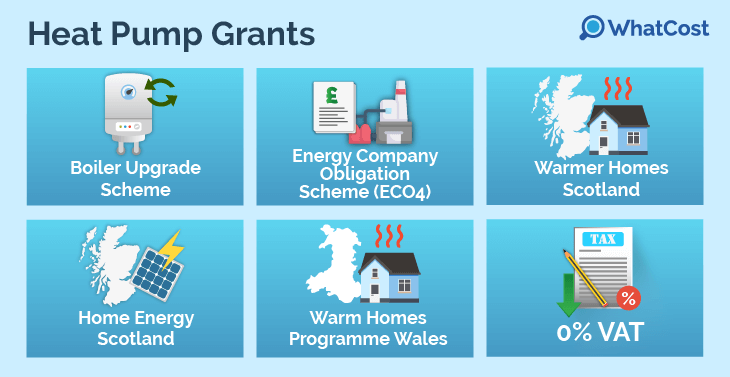
There is some good news though, as government-backed grants and schemes have begun to support more homeowners with installing heat pumps. For example, the Boiler Upgrade Scheme (BUS) has been running since 2022 and has steadily increased the number of installations.
Through the BUS, homeowners can apply for a grant of up to £7,500 for installing an air or ground source heat pump. The scheme was launched to encourage the switch from fossil fuel heating systems to low-carbon alternatives. Already in February 2024, over 4,000 installations were reported - a monthly increase of 26% on the previous year.
Other incentives can help with costs; these include:
-
Energy Company Obligation Scheme (ECO4)
The ECO4 helps low-income households to upgrade their homes with energy efficiency measures, including heat pump installations. Homes in England, Scotland, and Wales may benefit from the scheme.
-
0% VAT
The UK Government has reduced VAT to zero on many energy efficient technologies until 2027. This means huge savings can be made on the initial costs of installing a new system, including heat pumps.
-
Warmer Homes Scotland Grant and Loan
Homeowners in Scotland can apply for a grant, or interest-free loan, to help install energy efficient technologies, including air source heat pumps. Funding of £10,000 - £15,000 is available for eligible households.
-
Warm Homes Nest Scheme Wales
For homes in Wales, the Nest Scheme can cover the cost of installing a heat pump for households that meet the criteria.
Running costs of air source vs ground source heat pumps
To understand the average running costs of heat pump types, there are three main factors to consider:
-
The heat pump's efficiency
This is measured as a ‘Coefficient of Performance’ (COP) number. Heat pumps are usually rated between 2.5 and 4, indicating a heating/cooling output ratio against electrical energy used. The higher the COP, the more heat the unit will produce per unit of energy.
For example, if the COP is 3, the heat pump can produce 3x the heat per 1 unit of electricity.
-
Average heating needs/energy consumption of the household
This varies depending on household size, and the UK average may be more or less than you actually use. An excellent way to understand how much energy your home needs is to check your monthly bills for the kilowatt-hours (kWh) you have used.
-
Current energy costs
As heat pumps run on electricity, if you use energy from the National Grid (as opposed to solar panels, for example), you will be subject to fluctuating energy tariffs, which are the price per unit of electricity you use.
Using national energy use averages, based on different house sizes and current energy prices, we’ve outlined some estimated running costs below for different heat pump types.
| Annual Heat Pump Running Cost Comparisons | ||||
|---|---|---|---|---|
| Annual energy demand (kilowatt-hours) | House size | Air-to-air (COP 2) | Air-to-water (COP 3) | Ground source (COP 4) |
| 8,000kWh | 1 bedroom | £1,115 | £816 | £740 |
| 12,000kWh | 2 - 3 bedrooms | £1,592 | £1,132 | £906 |
| 17,000kWh | 4+ bedrooms | £2,250 | £1,793 | £1,404 |
Running costs can also differ depending on your property type. For example, whether your home is well insulated, the type of radiators you have, and whether you use any form of renewable energy (such as solar panels), can all impact how much you will spend to operate a heat pump.
Heat pump savings
Installing a heat pump offers you the opportunity to save money, but just how much you can save will largely depend on the system you currently have that you will replace. Savings can also differ if, for example, you replace an old, inefficient system, you change your usage habits or update your radiators.
Based on current UK energy prices, we’ve outlined some expected savings figures from the Energy Saving Trust below. These figures are based on installing a standard heat pump in a 3 - 4 bedroom home.
| Annual Savings Potential Per Heat Pump | ||
|---|---|---|
| System being replaced | Air source heat pump* | Ground source heat pump** |
| Old Gas Boiler (G-rated) | £260 | £480 |
| Old Electric Storage Heaters | £940 | £1,900 |
| Old Oil Boiler (G-rated) | £335 | £690 |
| Old LPG Boiler (G-rated) | £580 | £990 |
| Coal | £660 | £1,300 |
When assessing the costs and savings potentials of a heat pump installation, it’s good to keep in mind the lifespan of these systems. On average, you can expect 15 - 25 years of quality service when installed by a professional and regularly serviced.
Energy efficiency of air source and ground source heat pumps
Regarding energy efficiency, air source and ground source heat pumps are significantly more efficient than traditional heating systems but excel in different ways. As we’ve seen already, their efficiency can be up to 3 or 4 times higher than that of a gas boiler, which is measured using a Coefficient of Performance rating.
Air Source Heat Pumps typically have a COP of 2.5 to 3.5. This means for every 1kW of electricity used, they can produce 2.5 to 3.5kW of heat. However, their efficiency can drop significantly in colder climates where the pump has to work harder to extract heat from the air.
Ground Source Heat Pumps usually have a COP of 3.5 to 4.5. They use a constant ground temperature, resulting in more consistent efficiency year-round. This is especially true in colder areas, where air source efficiency suffers.
Looking at the chart below, we can see how differently the efficiency of each heat pump is affected by weather conditions. An air source heat pump is more affected as the temperature drops and its efficiency declines. This is because it has to work harder to create heat.
In contrast, a ground source heat pump can maintain a fairly stable efficiency level simply because underground temperatures are less likely to fall so drastically.

Efficiency is important to consider if you’re looking at running costs, as they could be slightly higher for an air source heat pump if you live in colder climates. A ground source heat pump is a much more stable and efficient long-term option but still comes with higher upfront costs to consider.
Suppose you're concerned about high energy use and its environmental impact. In that case, both systems can run on solar energy, which is great for reducing emissions and will cost you less in the long run.
Durability and quality of air source and ground source heat pumps
When making a significant investment like a heat pump, durability and overall system quality are important. There are some key differences between the two to consider.

Aside from the factors of durability and maintenance, you also need to think about what specific brands can offer, particularly with warranty coverage, materials used, and overall reputation.
While ASHPs offer a lower upfront cost, their shorter lifespan might mean more frequent replacements. GSHPs, though more expensive initially, have a longer lifespan and potentially lower maintenance needs due to the protected underground loop.
User-friendly features of air source and ground source heat pumps
When making any improvements or upgrades to your home, life must get easier and not more complicated. Heat pump technology is new to many homeowners; finding the right system that is easy to use and comfortable to live with is important.
Here are some of the user-friendly features for each heat pump type.

The best choice for you will depend on your priorities. Each heat pump offers convenient features to make its operation easier, however, some of these aspects are model-dependent. Overall, an ASHP does offer a more straightforward installation and setup with smart features, while the GSHP can offer a more consistent and quieter operation.
Advantages and disadvantages of air source and ground source heat pumps
We’ve compiled a quick overview of the pros and cons for each type of heat pump to give you a clear comparison.
Air source heat pumps
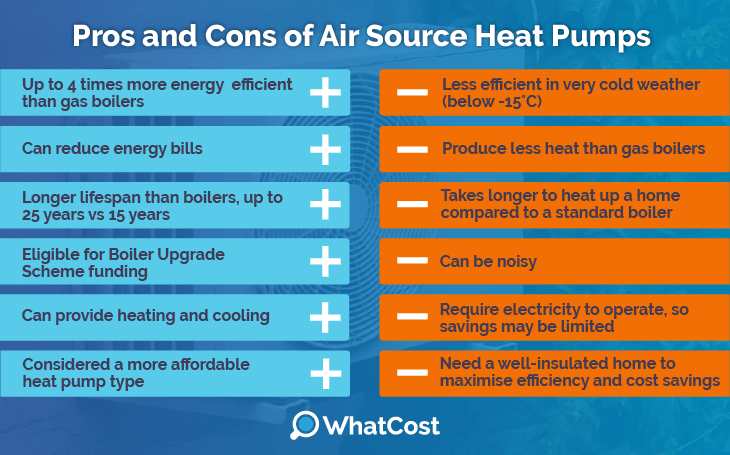
In summary, air source heat pumps offer significant efficiency, environmental, and cost benefits compared to traditional heating systems. They do require careful consideration however of factors like climate, home insulation, and compatibility. Long-term savings and government incentives can offset the higher upfront costs.
Ground source heat pumps
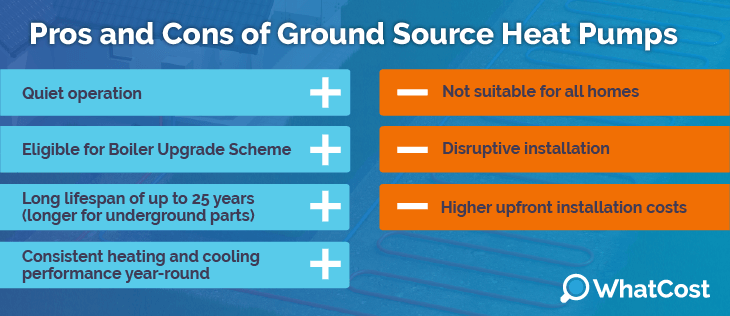
Environmental impact of air source heat pumps vs ground source heat pumps
Air source and ground source heat pumps both offer a significantly greener alternative to traditional heating systems, which rely on fossil fuels. However, it’s important to consider their overall impact on the environment when thinking about whether to install this technology.
We’ve highlighted some of the important impacts that heat pumps have on our environment, as well as some of the concerns you might want to consider.
Examples of the effects of air and ground source heat pumps
| The Impact of Heat Pumps | |
|---|---|
| Positive Impacts | |
| Reduced carbon emissions | Both significantly reduce carbon emissions compared to traditional heating systems, as they avoid the combustion of fossil fuels. They do, however, use electricity to operate, which still has a carbon footprint. If replaced with solar energy, the environmental impact is almost eliminated. |
| Efficient energy usage | Heat pumps can be up to 400% energy-efficient, producing multiple units of heat for each unit of electricity consumed. This efficient conversion of electricity into heat minimises energy waste and reduces environmental impact. |
| Use of renewable energy | Air and ground heat are a form of renewable energy taken from existing natural sources. This helps reduce reliance on finite and polluting fossil fuels such as gas, oil and coal. |
| Potential Negative Impacts | |
| Lifecycle | It’s important to consider the full lifecycle impact of a heat pump - including manufacturing, transportation, installation, maintenance, and disposal. |
| Refrigerant concerns | There is a risk that the refrigerants used in air source heat pumps could leak and contribute to environmental pollution if not properly managed. However, the use of low-GWP (global warming potential) refrigerants can help mitigate this concern. |
In summary, both ground and air source heat pumps are considered environmentally friendly heating and cooling solutions. They offer significant reductions in carbon emissions, efficient energy usage, and utilisation of renewable heat sources. Proper management of refrigerants and consideration of the entire lifecycle impact are important to maximise their environmental benefits.
What to consider when choosing a ground source heat pump or air source heat pump
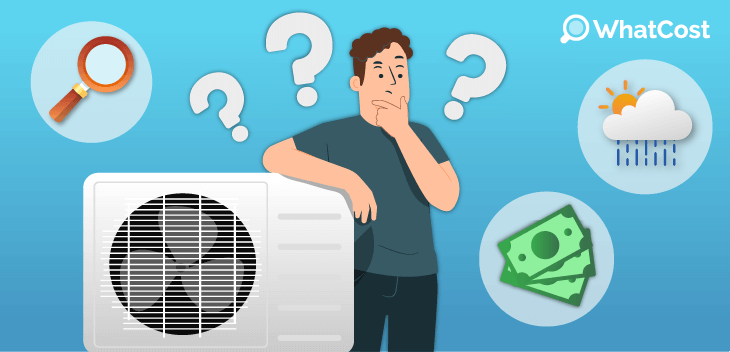
Choosing which heat pump is best for your home will largely depend on your budget, property type, and overall heating or cooling needs. Below is a quick checklist to ensure you consider all of the most important points:
-
Climate conditions:
Consider the climate where you live, especially if it experiences very cold temperatures. Ground source heat pumps do better in colder places, but specialised ‘cold climate’ heat pump models are becoming more widely available.
-
Property size/space:
Pick a heat pump type and model that will work in your space. An oversized outdoor air source unit could take up valuable space in a small garden. Alternatively, you may not have the required land area to accommodate an adequately sized ground source heat pump. Seek professional advice before committing to one if you're worried about space.
-
Energy efficiency:
Look for high efficiency ratings, particularly the Coefficient of Performance (COP). You can also see how energy efficient a product is by its ErP (Energy-related Performance) rating - for example, most heat pumps should be in the A to A+++ range, indicating that it’s producing more energy than it’s using.
Features like smart controls, zoning or variable speeds are also good to look for as they can help reduce unnecessary use and minimise energy waste.
-
Existing heating/cooling system compatibility:
Decide whether you want your heat pump to heat your water as this will focus your search. An air-to-water heat pump can provide both, but an air-to-air cannot. You will also need to ensure your existing heating or cooling systems are compatible with your choice unless you wish to replace parts of your set-up. For example, you may need to upgrade your radiators to get the most from an air source heat pump.
-
Other considerations:
Ensure your electrical supply/home wiring is sound and able to support the power needs of a heat pump (older homes may need some rewiring). Also, maintenance, accessibility, and any after-sales support should be considered by checking brand reputation and supplier reviews.
Size of heat pumps
When we talk about heat pump size, we can mean two things: the physical size of a heat pump unit (and its component parts) or the output size (meaning how powerful it is in kilowatts).
The first thing to understand is the physical aspect. You must ensure you have enough space outdoors for either an air source fan unit or the larger land requirements of a ground source heat pump.
In both cases, there may also be a need for indoor units. In particular, with an air source heat pump, you will find two types of units: monobloc or splitsystem. This means that you have the fan and compressor combined in one unit outdoors (monobloc) or the fan outdoors and the compressor indoors (split). The main difference is really down to space, but some cost differences may be involved.
The compressor is the part of the system that pressurises the refrigerant to increase its temperature.
In terms of the physical space you can expect these units to take up, here are some estimates:
| Space Required per Heat Pump Type | ||
|---|---|---|
| External space | Internal space | |
| Air-to-air source heat pump | 1 - 2m2 Up to 1m high, 1.2m wide. Clearance of 0.6m on all sides. | 15 - 25 cm per duct/vent. Up to 1.5m for indoor air circulating unit (air handler). |
| Air-to-water source heat pump | 1 - 2m2 Up to 1.5m high, 1m wide. Needs 1m clearance on each side (0.3m behind). | 13.6m2 For all internal parts (e.g. heat exchange unit, hot water cylinder and large radiators). |
| Ground source heat pump | Horizontal loops (Trenches): 600 - 1200m2 1 - 2m deep trenches, 100m long (2 - 3 loops for average home). Vertical loops (Boreholes): 11m2 70 - 120m deep holes, 5 - 6m apart (3 boreholes for the average home). | 16.6m2 3m2 for the indoor unit, 13.6m2 for other components: heat exchange unit, hot water cylinder, and larger radiators. |
After you have understood the physical space needed to install a heat pump, you will also need to know how powerful your system should be. This is based on the size and demands of your property. It’s important to get this right: if you get a heat pump that is oversized/too powerful, it will cycle on and off frequently, too small, and it won't adequately heat/cool the home - this will lead to energy waste, higher bills and unnecessary emissions.
Below are some guideline estimates for each home size and the power output of the heat pump you will need. Please note these are estimates only. For an accurate idea of what your home requires, we recommend that you seek advice from professional installers.
| Size of the Home | Estimated Annual Energy Demand | Estimated Required Air Source Heat Pump Size | Estimated Required Ground Source Heat Pump Size |
|---|---|---|---|
| 1 bedroom | 8,000 kWh | 3kW | 4kW |
| 2 - 3 bedrooms | 12,000 kWh | 4 - 5kW | 8kW |
| 4 bedrooms | 17,000 kWh | 10kW | 12kW |
| 5+ bedrooms | 21,000 kWh | 16kW | 16kW |
Are heat pumps compatible with traditional heating systems?
Heat pumps can work with traditional heating systems, such as boilers and hot water cylinders. You just need to ensure the make/model you choose is compatible. Here are some examples of how they might work.
-
Compatibility with radiators
Heat pumps can work with existing radiator systems and pipework. Some radiators may need to be upgraded or oversized, however, to accommodate the lower operating temperatures of a heat pump. This is because heat pumps are more efficient at distributing heat at lower temperatures compared to the higher temperatures produced by traditional boilers.
-
Hybrid/Dual-fuel systems
You can integrate a heat pump with traditional gas or oil boilers in a hybrid or dual-fuel heating system. This allows the heat pump to operate as the primary heating source, with the traditional system providing supplemental heating during very cold weather when the heat pump's efficiency decreases. The two systems work together to provide whole-home heating in the most efficient and cost-effective manner.
-
Underfloor heating
Underfloor heating systems are considered the best match for heat pumps, as the large surface area allows them to operate efficiently at the lower temperatures of heat pumps.
Maintenance and upkeep of ground source vs. air source heat pumps
Installing a heat pump can come with many benefits, but there is some maintenance and upkeep that need to be considered. Ensuring your heat pump operates effectively and efficiently will prolong its life and help you get the most efficient performance.
Below is a comparison of key maintenance points for each type of heat pump.
| Heat Pump Maintenance Per Type | ||
|---|---|---|
| Air source heat pump maintenance needs | Ground source heat pump maintenance needs | |
| Cleaning and inspections | Regular cleaning and inspection of the coils, fans, and filters to remove any debris that could restrict airflow. Visually inspect the unit for any obstructions or damage to the components. Check the condensate drain to ensure it is clear and free-flowing. | GSHPs have filters that require regular cleaning or replacement, depending on the manufacturer's recommendations. Clean filters are essential for maintaining air quality and system efficiency. |
| Checks for problems | Inspect the unit for any signs of wear, such as damaged belts or loose connections, and replace or tighten components as needed. Monitor the system for any changes in performance that could indicate a problem. | Familiarising yourself with the GSHP's features and adjusting settings for optimal performance across different seasons is crucial. |
| Professional servicing | Annual servicing by a professional, which should include checking refrigerant levels, testing electrical components, and ensuring the system operates within manufacturer specifications. Annual servicing is often required to maintain the manufacturer's warranty. | Annual inspections by a qualified technician are recommended to check key components like the heat pump, circulation pump, and thermostat. These inspections help identify potential issues early to prevent costly repairs. |
| Maintenance | Ensuring clean and unobstructed ducts is important for systems that utilise ductwork for air distribution. | The buried ground loop is relatively low-maintenance, but the antifreeze solution needs to be checked and adjusted periodically by professionals. |
Heat pumps are generally considered low maintenance compared to other heating options. This is partly because they don’t involve the same safety risks associated with combustion. When properly maintained, they also offer a longer lifespan than traditional boilers.
Which heat pump is the most recyclable?
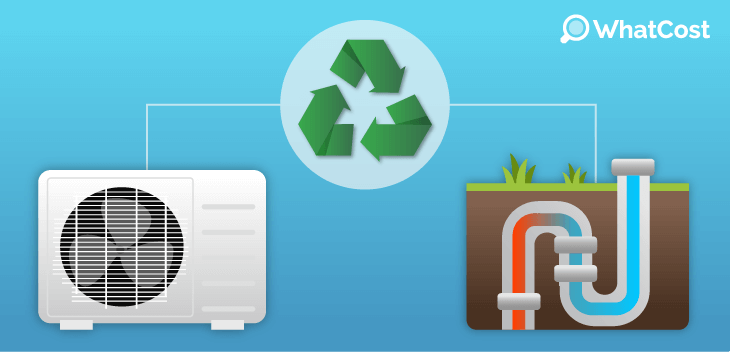
If you’re concerned about what happens to your heat pump after its lifetime (which is expected to be between 15 - 25 years!), then there are some things you can do. Firstly, when researching a heat pump model, you can look for manufacturers who offer recycling or focus on using recyclable materials.
Many manufacturers will highlight using recyclable materials in their products, but it’s worth discovering if, or how, you can recycle something after use. To get a good understanding of a heat pump's recyclability, you can look for the following points:
Look for brands with sustainability initiatives
Some heat pump brands may prioritise sustainability in their manufacturing processes. These brands might be more likely to use recyclable materials and have take-back/collection programmes for old units. There are a few examples of this in the UK:
-
Mitsubishi Electric Recycling Programme
This programme helps homeowners recycle various heating and cooling technologies, including heat pumps nearing the end of their usable life. It aims to reduce environmental impact by keeping this equipment out of landfills.
Through the programme, old Mitsubishi Electric equipment can be conveniently collected, and a certificate can be issued to confirm safe and responsible disposal. The units are then dismantled, and materials are recovered for reuse.
Mitsubishi states that up to 98% of materials can be recycled and reused in new products. This reduces strains on natural resources and the need to produce virgin materials. The process includes:
- separating steel and copper from compressors;
- removing refrigerant and processing it for reuse or destroying it (through high-temperature incineration) to avoid environmental damage; and
- separating other materials for reuse in various industries.
-
Alto Energy IVT Heat Pump Recycling Scheme
Alto Energy offers a trade-in recycling scheme. It offers a discount of up to £1,200 off a brand new IVT Greenline ground source or air source heat pump when you trade in an old IVT model. They also offer free collection and responsible recycling.
Due to this programme, IVT heat pumps are considered one of the most recyclable models.
Consider material composition
Generally, heat pumps are made from a combination of metals (mainly steel and copper), plastics, and refrigerant or brine. Steel and copper are highly recyclable, while plastics have limitations. Some refrigerants can also be harmful to the environment, but in many cases can be reused or recycled if handled correctly.
Choose reputable installers
A good installer can advise you on heat pumps known for using recyclable materials or companies which offer responsible disposal of old units when replacing them.
Remember, choosing a heat pump with a high emphasis on recyclable materials is a good first step. However, responsible disposal through certified programs is equally important for maximising the environmental benefits.
Which heat pump type is most suitable for your home?
When deciding if an air source or ground source heat pump is best for your home, there are some specific factors to consider. We’ve outlined the most important points below so you can compare each heat pump type and see how it fits your needs.
| Air Source Vs. Ground Source Heat Pump | ||
|---|---|---|
| Requirements | Air source heat pumps | Ground source heat pumps |
| Available Space | Requires outdoor space for the fan unit and indoor space for hot water systems or air vents/ducts. Also, account for any radiator upgrades. | Sufficient outdoor space is needed for the ground loops, either horizontally in trenches or vertically in boreholes. Indoor space is also required for a processing unit and hot water storage, if needed. |
| Insulation / Efficiency | Requires a well-insulated home to operate efficiently. | Requires a well-insulated home to operate efficiently. |
| Radiators | For traditional radiators, a high-temperature pump is needed. For underfloor heating, standard heat pump temperatures are ideal. | For traditional radiators, a high-temperature pump is needed. For underfloor heating, standard heat pump temperatures are ideal. |
| Property type | Suitable for most homes, including flats. | Suitable for most homes but require land space for ground loops. |
It is always recommended that you speak to a professional installer for the best advice based on your home's specific needs.
Do ground source and air source heat pumps have user experience?
According to a study published by Nesta in 2023, users have a very positive overall experience of using heat pumps compared to gas boilers. The study was one of the largest to survey heat pump owners across the UK.
Here are some interesting user results from the survey:
-
Over 70% of heat pump owners surveyed reported being "very satisfied" or "fairly satisfied" with their systems.
-
When compared to their previous traditional heating system, 73% were "as satisfied" or "more satisfied" with their heat pump.
-
Users were highly satisfied with their safety (92%), reliability (85%) and effectiveness in heating hot water (89%).
-
Those living in older, Victorian houses find equal satisfaction to those in modern homes - suggesting heat pumps are effective in various property types.
-
Users are more likely to be satisfied with the running cost of a heat pump than that of a gas boiler.
- 85% of users felt heat pumps are unobtrusive and were satisfied with noise levels.
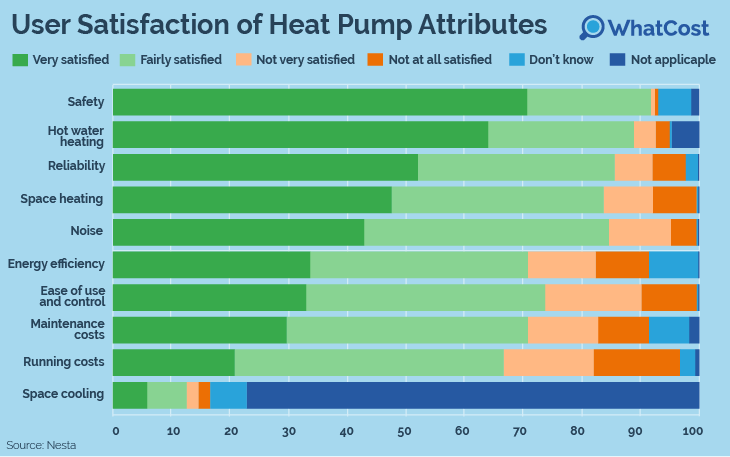
These survey results indicate that heat pump owners are more satisfied with their heat pumps than traditional gas boilers. In particular the safety, reliability, and effectiveness of these systems.
Heat pump tips to consider
Heat pumps are a fantastic way to heat and cool your home, but just like any appliance, there are ways you can ensure their optimised performance to maximise their benefits. These can include simple maintenance tricks to large annual undertakings.
Here are some of the best tips to get the most out of a heat pump:
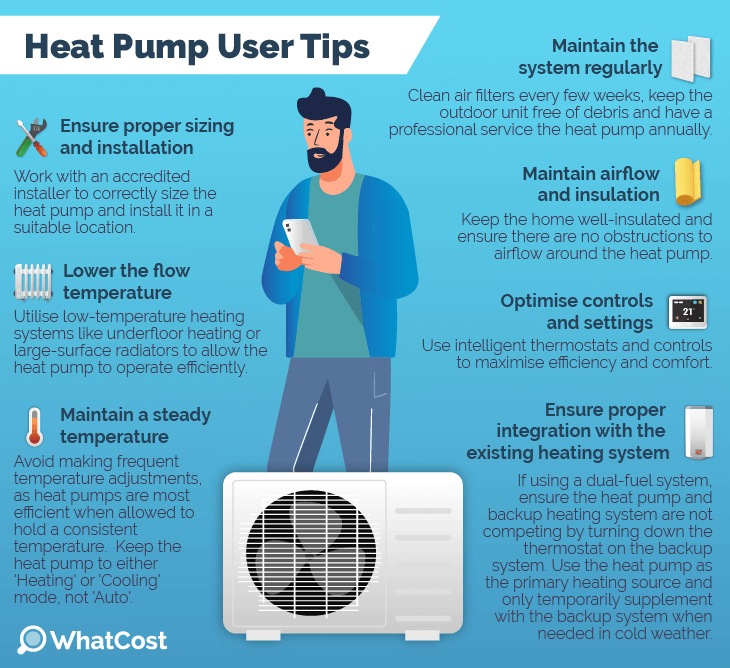
Expert opinions and recommendations
While heat pumps offer a great way to achieve comfort and energy savings, consulting with experts can further enhance your experience. You should also seek advice from a professional installer before choosing a heat pump type. This ensures your home gets exactly what it needs from the technology, and that you get a system that works for you.
We’ve researched what installers and heating experts are likely to advise for those looking for a heat pump and listed some of these opinions and recommendations below.
-
Correct sizing:
According to the Energy Saving Trust (EST), a properly sized heat pump is crucial for optimal performance. An oversized unit will cycle on and off more frequently, reducing efficiency, while an undersized unit might struggle to meet your heating needs. A qualified technician can calculate heat load to determine the perfect size for your home.
-
Regular maintenance:
The EST also emphasises the importance of regular maintenance. This typically involves cleaning air filters and scheduling professional checkups every 1-2 years to ensure proper operation.
-
Professional installation:
Experts recommend professional installation for heat pumps. Improper installation can lead to efficiency losses and potential equipment damage. A qualified installer will ensure your heat pump is sized and placed correctly for optimal function.
-
Optimum thermostat settings:
Experts at Which? advise setting your thermostat to a consistent temperature and avoiding frequent adjustments. Heat pumps work most efficiently when maintaining a steady temperature rather than constantly ramping up and down.
-
Pairing with a smart thermostat:
Experts see smart thermostats as a valuable tool for maximising heat pump efficiency. These thermostats allow for programming heating and cooling schedules, to reduce energy use when you're away or asleep.
Following these expert recommendations, and some of the general tips we discussed earlier, will put you well on your way to enjoying a comfortable and cost-effective experience with your heat pump.
Final verdict: Choosing between air and ground source heat pumps
So, which reigns supreme: air source or ground source heat pumps? The truth is, there's no single "best" option. Both technologies offer distinct advantages and disadvantages; the ideal choice hinges on your circumstances. Here's a quick recap to help you decide:
-
Air source heat pumps:
Choose an ASHP if budget is a top concern and your climate experiences mild winters. They boast a simpler installation process and lower upfront costs.
-
Ground source heat pumps:
If you prioritise consistent comfort, lower running costs, and minimal maintenance, a GSHP is better, especially in colder climates. However, be prepared for a higher upfront investment and a more complex installation process.
The best course of action is to consult with a qualified professional. They can assess your home's specific needs, climate factors, and budget to recommend the most suitable heat pump solution for achieving optimal comfort and energy efficiency.
Considering all the factors and seeking expert advice, you can ensure your heat pump investment delivers on what’s most important to you and your household.
Frequently asked questions
Ground source heat pumps have higher installation costs and require dedicated land area. This can be a barrier for many, particularly those with less ground space. However, an air source heat pump might be a cheaper alternative providing the same benefits.
Ground source heat pumps are typically more efficient than air source heat pumps, as they are less affected by outdoor temperatures. The choice between the two also depends on available space, budget, and heating needs.
Geothermal (ground source) heat pumps are generally more energy efficient than air source heat pumps. They extract heat from the relatively constant temperature of the ground, while air source heat pumps must work harder as outdoor air temperatures fluctuate.
Ground source heat pumps are more efficient and cost-effective in the long run than air source heat pumps. However, ground source heat pumps cost more upfront and require more space.

Becky has been bringing quality advice to homeowners since 2021. As an experienced writer, she is keen to help our customers find the help they need when they need it.
- Air Source Heat Pumps vs Ground Source Heat Pumps: Which Is Better?
- Understanding how heat pumps work
- Comparing air source vs ground source heat pumps
- Environmental impact of air source heat pumps vs ground source heat pumps
- What to consider when choosing a ground source heat pump or air source heat pump
- Which heat pump is the most recyclable?
- Which heat pump type is most suitable for your home?
- Heat pump tips to consider
- Expert opinions and recommendations
- Final verdict: Choosing between air and ground
- Frequently asked questions

